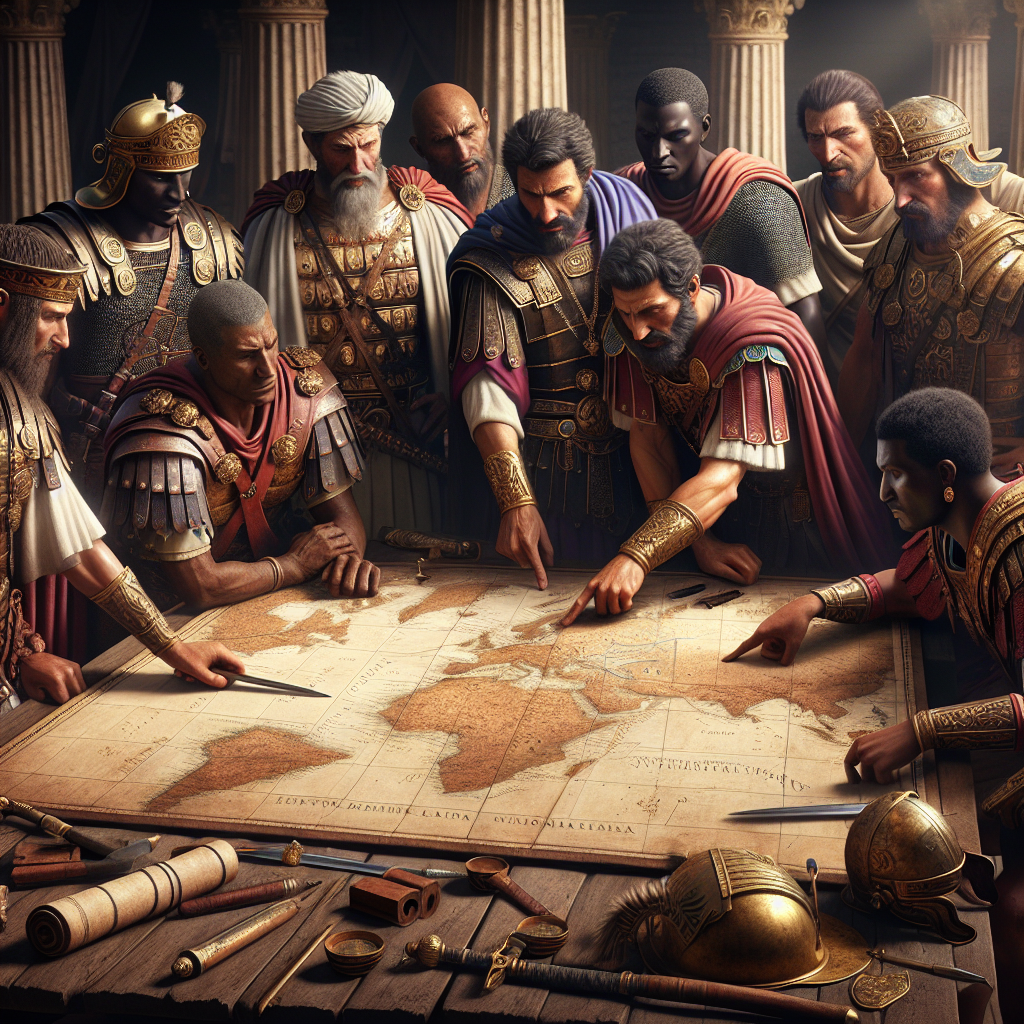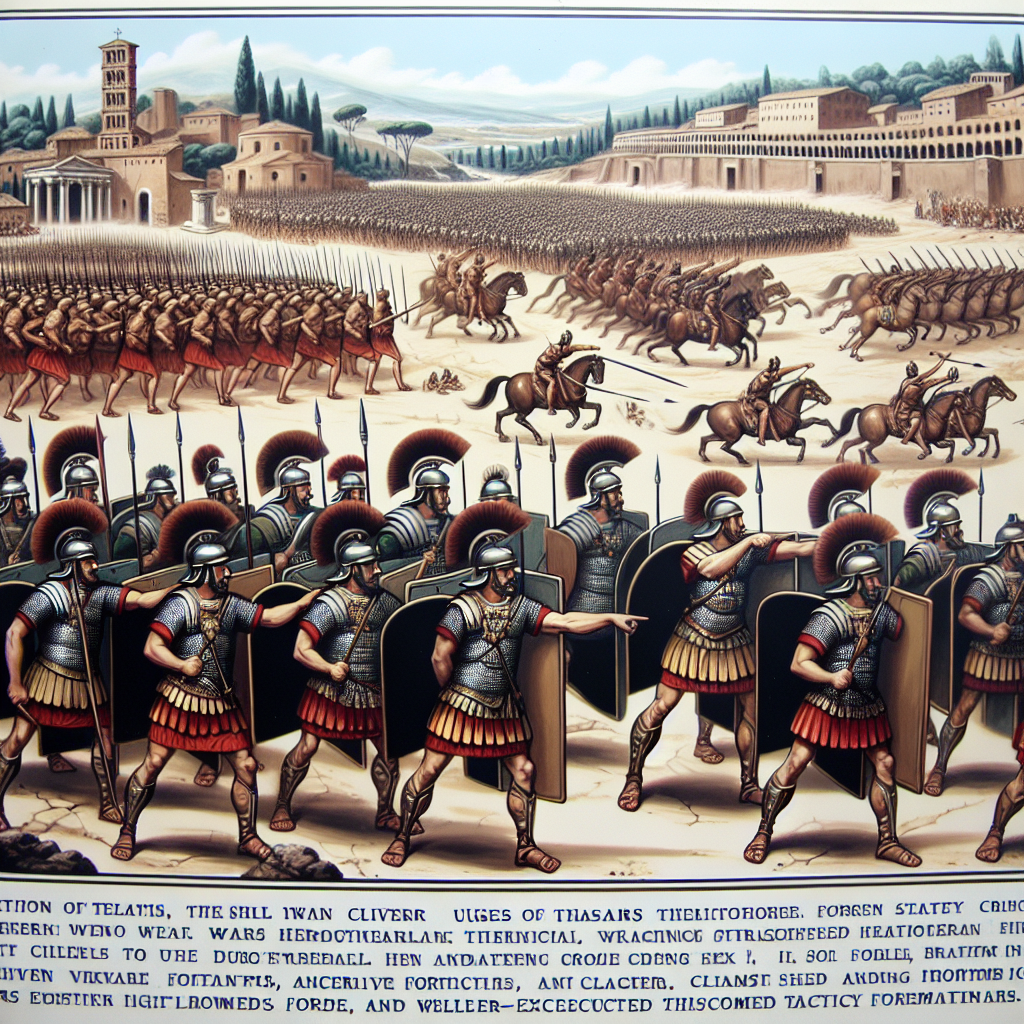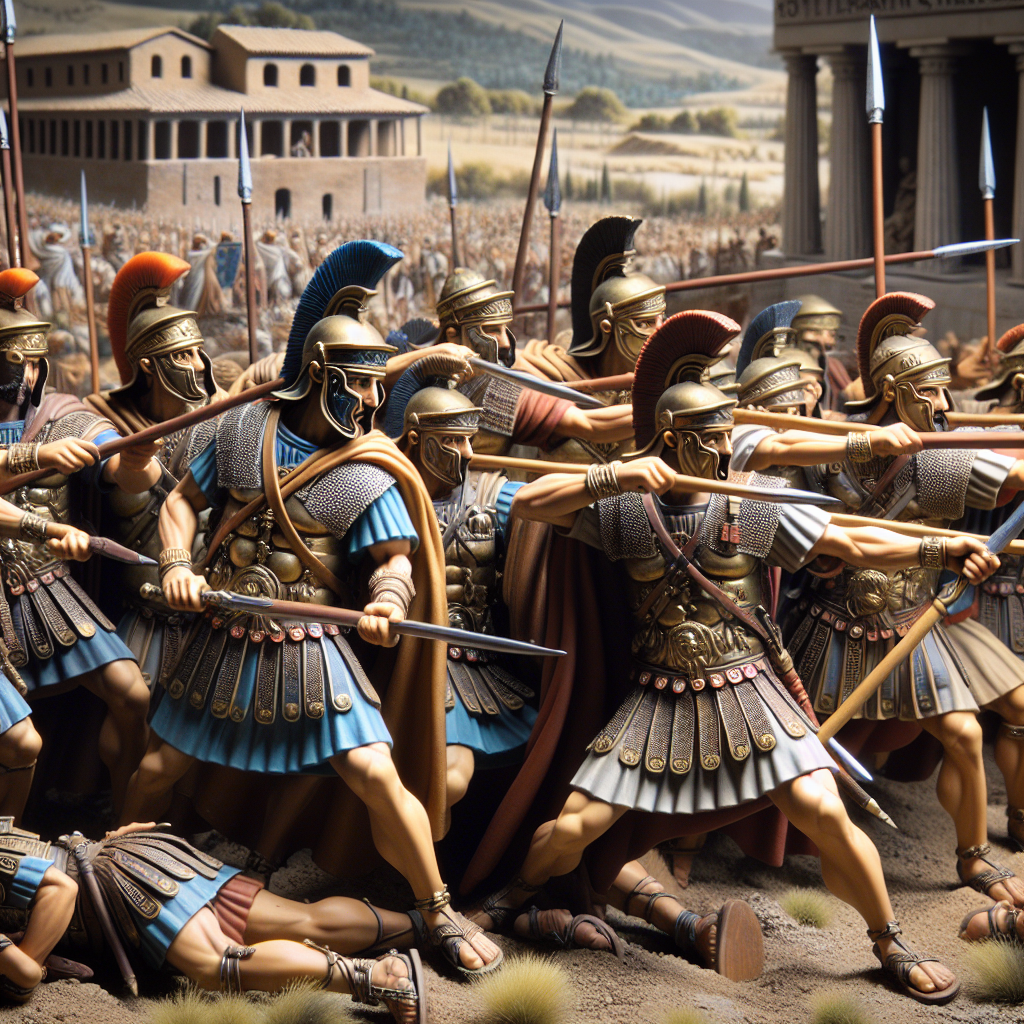Ancient Rome, a civilization renowned for its military prowess and strategic brilliance, implemented a variety of innovative tactics that revolutionized the art of warfare. From the disciplined formation of the Roman legions to the utilization of engineering skills in siege warfare, Roman military strategy was unrivaled in its complexity and effectiveness. This ancient empire’s success on the battlefield can be attributed to a combination of meticulous planning, adaptability, and sheer determination. By delving into the military campaigns and tactics employed by the Romans, we can gain a deeper understanding of their strategic mindset and how it ultimately shaped the course of history. Join us as we unveil the strategic brilliance of military strategy in ancient Rome.
The Foundation of Roman Military Prowess

Organization of the Roman Army
-
Legions and Cohorts
The Roman army was structured into legions, each consisting of around 5,000 heavily armed infantry soldiers known as legionaries. Legions were further divided into cohorts, with each cohort having around 480 men. This organizational structure allowed for flexibility and effective command during battles. -
Command Structure
The Roman army had a hierarchical command structure that ensured clear communication and swift decision-making on the battlefield. At the top was the overall commander, usually a consul or a general, followed by senior officers such as tribunes and centurions who led individual units within the army. This chain of command facilitated coordination and unity of action.
Training and Discipline
-
Rigorous Training Regimens
Roman soldiers underwent rigorous training from a young age, emphasizing physical fitness, weapon proficiency, and tactical skills. Training exercises included marching long distances with heavy packs, mock battles, and weapons practice to ensure that soldiers were well-prepared for the challenges of warfare. -
Importance of Discipline in Battle
Discipline was a cornerstone of Roman military success, with strict adherence to orders and formations being paramount on the battlefield. Roman soldiers were trained to maintain composure under intense pressure, follow commands without hesitation, and work together seamlessly as a cohesive unit. This discipline gave the Roman army a significant advantage in combat situations, enabling them to outmaneuver and outlast their opponents.
Tactics and Formations: The Art of War
The military strategy employed by Ancient Rome was a testament to their strategic brilliance, with a key focus on tactics and formations that set them apart on the battlefield.
- Manipular Formation
The Manipular Formation was a hallmark of Roman military tactics, offering distinct advantages in terms of flexibility and adaptability. This formation consisted of small, organized units known as maniples, which could be maneuvered independently on the battlefield. This allowed the Roman legions to respond swiftly to changing circumstances, outmaneuvering their enemies with strategic precision.
- Advantages and Adaptability
One of the primary advantages of the Manipular Formation was its ability to adapt to various combat situations. The maniples could be arranged in different configurations based on the terrain and the tactics employed by the enemy, providing the Roman legions with a versatile approach to warfare. This adaptability ensured that the Roman army could effectively engage different types of adversaries, from heavily armored infantry to fast-moving cavalry units.
- Maneuverability in Battle
The flexibility of the Manipular Formation also granted the Roman legions superior maneuverability on the battlefield. By dividing their forces into smaller units, the Romans could execute complex tactics such as flanking maneuvers and encirclements with ease. This strategic agility not only caught their enemies off guard but also allowed the Romans to maintain control over the course of the battle, dictating the flow of combat to their advantage.
- Testudo Formation
In addition to the Manipular Formation, the Romans also utilized the Testudo Formation as a defensive strategy against missile attacks. This formation involved overlapping shields held closely together to form a protective shell around the soldiers. The Testudo Formation was particularly effective against projectiles such as arrows and javelins, as the shields provided a solid barrier that deflected incoming missiles.
- Defensive Strategy
The Testudo Formation served as a vital component of Roman defensive tactics, enabling the soldiers to withstand barrages of enemy fire while maintaining their cohesion on the battlefield. This defensive strategy not only protected the troops from harm but also allowed them to advance steadily towards their objectives, even in the face of intense opposition. The disciplined coordination required to execute the Testudo Formation reflected the Roman army’s meticulous training and unwavering discipline in the heat of battle.
- Protection against Missiles
By adopting the Testudo Formation, the Roman soldiers minimized their vulnerability to missile attacks, effectively neutralizing one of the most common tactics employed by their adversaries. The tightly packed shields created a shield wall that covered the soldiers from head to toe, leaving little room for enemy projectiles to find their mark. This defensive shield wall not only shielded the individual soldiers but also safeguarded the integrity of the unit as a whole, reinforcing the Roman army’s reputation for strategic brilliance in both offense and defense.

Siege Warfare: Breaking the Enemy’s Defenses
In Ancient Rome, siege warfare was a crucial aspect of military strategy that showcased the empire’s engineering prowess and strategic acumen. The Romans excelled in the art of breaking through enemy defenses through a combination of innovative engineering expertise and tactical ingenuity.
Engineering Expertise
The Roman military’s engineering expertise was unparalleled in the ancient world, enabling them to construct formidable siege weapons that could breach even the most fortified enemy walls. These weapons were meticulously designed and crafted to withstand the rigors of warfare and deliver maximum impact on the battlefield.
Construction of Siege Weapons
Central to the Roman approach to siege warfare was the construction of specialized siege weapons that could effectively dismantle enemy defenses. Among the most notable siege weapons employed by the Romans were the siege tower and the battering ram. The siege tower provided a mobile platform for Roman soldiers to launch assaults from a height, gaining a tactical advantage over defenders. The battering ram, on the other hand, was a powerful tool used to break through gates and walls, symbolizing the relentless determination of the Roman forces.
Siege Tactics
In addition to their advanced siege weaponry, the Romans employed a range of sophisticated siege tactics to weaken and ultimately conquer enemy fortifications. One such tactic was the imposition of a blockade and isolation strategy, cutting off crucial supply lines and isolating the besieged city or fortress from reinforcements. This not only deprived the defenders of essential resources but also exerted psychological pressure, sowing discord and desperation among the enemy ranks.
Psychological Warfare
Psychological warfare was another critical element of Roman siege tactics, aimed at demoralizing the enemy and hastening their surrender. The Romans utilized various psychological tactics, such as propaganda, intimidation, and the display of military might, to instill fear and uncertainty in the hearts of their adversaries. By creating a sense of inevitability and overwhelming force, the Romans effectively undermined the morale and resilience of those facing their siege.
In conclusion, the military strategy of Ancient Rome in siege warfare was a testament to the empire’s strategic brilliance, combining engineering prowess, tactical innovation, and psychological warfare to break through enemy defenses and secure victory on the battlefield.
Naval Warfare: Dominance at Sea
Naval Fleet Development
-
Quinqueremes and Triremes
Ancient Rome’s naval power was characterized by the development of advanced warships such as quinqueremes and triremes. These vessels were equipped with multiple rows of oars, allowing for greater speed and maneuverability during naval engagements. The Romans invested heavily in building and maintaining these sophisticated ships to ensure their dominance at sea. -
Naval Bases and Ports
Strategic naval bases and ports played a crucial role in Rome’s maritime supremacy. These facilities served as vital hubs for the Roman navy, providing shelter, supplies, and repair services for the fleet. By strategically positioning their naval bases along key trade routes and coastlines, the Romans were able to exert control over important maritime territories.
Naval Tactics
-
Ramming and Boarding
One of the primary naval tactics employed by the Romans was the use of ramming and boarding techniques during sea battles. Roman warships were equipped with reinforced prows designed to ram into enemy vessels, causing damage and creating opportunities for boarding parties to launch attacks. This aggressive tactic allowed the Romans to quickly disable and capture enemy ships, effectively neutralizing threats at sea. -
Control of Sea Lanes

Control of sea lanes was essential for maintaining dominance at sea. The Romans implemented strategic naval blockades and patrols to regulate maritime traffic and prevent enemy incursions. By effectively controlling key sea lanes, the Roman navy could safeguard trade routes, protect coastal territories, and project power across the Mediterranean region.
Strategic Adaptations: Flexibility in the Face of Challenges
Military strategists in Ancient Rome displayed remarkable adaptability in the face of various challenges, showcasing their strategic brilliance. By analyzing their innovations in tactics, adoption of enemy strategies, and flexibility in terrain warfare, we can uncover the depth of their strategic prowess.
- Innovations in Tactics
- Roman commanders were known for their innovative approach to warfare, constantly developing new tactics to outmaneuver their opponents.
- The Roman manipular formation, with its flexible and adaptable structure, allowed for quick adjustments on the battlefield based on the enemy’s movements.
-
By incorporating tactics such as the testudo formation for protection against missile attacks, the Romans demonstrated their ability to think creatively in the heat of battle.
-
Adoption of Enemy Strategies
- Rather than relying solely on their own tactics, Roman generals were not afraid to adapt and adopt strategies used by their adversaries.
- By studying and implementing successful enemy tactics, such as the use of cavalry by the Parthians, the Romans were able to enhance their own military capabilities and stay ahead of their foes.
-
This willingness to learn from their enemies and incorporate effective strategies into their own repertoire contributed to the Romans’ overall success on the battlefield.
-
Flexibility in Terrain Warfare
- One of the key strengths of the Roman military was their ability to adapt to various terrains and environmental conditions during warfare.
- Whether fighting in the rugged mountains of the Alps or the hot deserts of North Africa, Roman soldiers were trained to adjust their tactics and strategies accordingly.
- This flexibility in terrain warfare enabled the Roman army to overcome geographical challenges and emerge victorious in diverse battlefield settings.
By examining these aspects of strategic adaptations in Ancient Rome, we can gain valuable insights into the military genius that underpinned the empire’s success in conquest and expansion.
Legacy of Roman Military Strategy: Influence and Impact
The spread of Roman tactics across ancient battlefields had a profound impact on the evolution of military strategies throughout history. The meticulous organization and disciplined formations of the Roman legions became a model emulated by many civilizations.
- Spread of Roman Tactics
- Phalanx formations and manipular tactics were widely adopted by other armies.
-
The Roman emphasis on training, logistics, and engineering influenced military doctrines for centuries.
-
Influence on Later Military Strategies
- The concept of dividing the army into smaller, more maneuverable units was a Roman innovation that influenced the development of modern military tactics.
-
Roman strategies, such as sieges and envelopment maneuvers, were studied and implemented by military leaders in subsequent eras.
-
Legacy in Modern Warfare
- The Roman legacy can be seen in the hierarchical command structures and emphasis on discipline that are still prevalent in contemporary armed forces.
-
Military academies and training programs often study Roman campaigns as a foundation for understanding strategic principles.
-
Lessons for Today
- The adaptability and flexibility of Roman military tactics serve as a reminder of the importance of being able to adjust strategies in response to changing circumstances.
- The meticulous planning and execution of Roman campaigns highlight the significance of thorough preparation and coordination in achieving strategic objectives.
FAQs – Military Strategy in Ancient Rome
What were some key military strategies used by ancient Romans?
Ancient Romans employed a variety of military strategies that contributed to their success on the battlefield. One key strategy was the formation of the legions, which were highly organized and disciplined units that allowed for effective coordination and communication during combat. The Romans also utilized tactics such as the phalanx formation, which involved soldiers forming a dense, shielded formation to protect themselves from enemy attacks. Additionally, the Romans were known for their engineering prowess, using techniques such as siege warfare to conquer enemy fortifications.
How did ancient Romans adapt their military strategies to different terrain and enemies?
Ancient Romans were adept at adapting their military strategies to suit the terrain and the capabilities of their enemies. In hilly or mountainous regions, they would use their engineering skills to build roads and fortifications to provide better access and defense. When facing enemies with superior numbers or cavalry, the Romans would utilize tactics such as the tortoise formation, where soldiers would lock their shields together to form a protective shell. They also made use of espionage and intelligence gathering to gather information about their enemies and tailor their strategies accordingly.
What role did leadership play in ancient Roman military strategy?
Leadership was crucial in ancient Roman military strategy, with skilled commanders playing a significant role in the success of their armies. Roman generals such as Julius Caesar and Scipio Africanus were known for their tactical acumen and ability to inspire and lead their troops to victory. These leaders would devise battle plans, make strategic decisions, and adapt to changing circumstances on the battlefield. Additionally, Roman military hierarchy emphasized discipline and obedience, ensuring that soldiers followed orders and worked together as a cohesive unit under their commanders’ guidance.
0 Comments